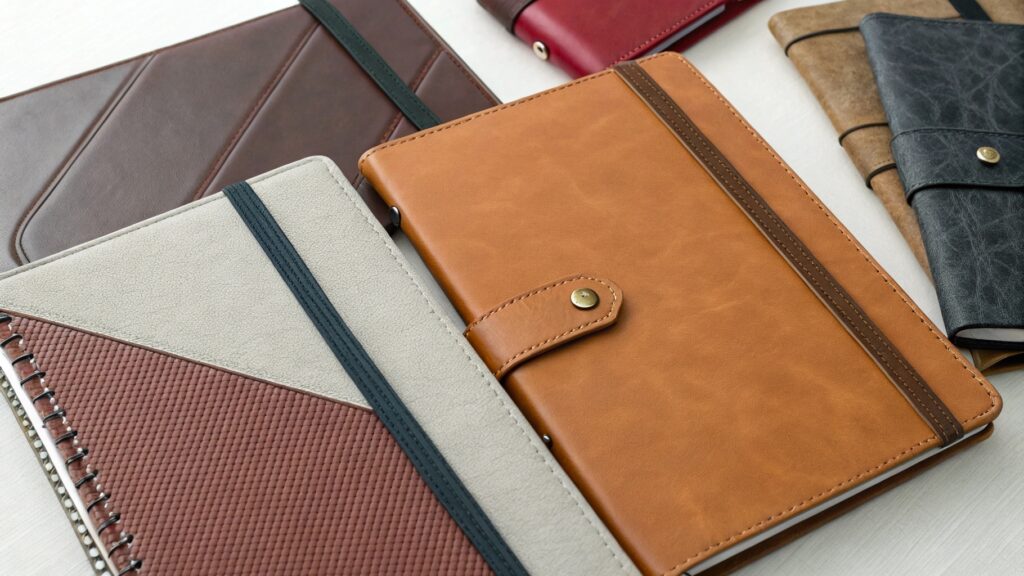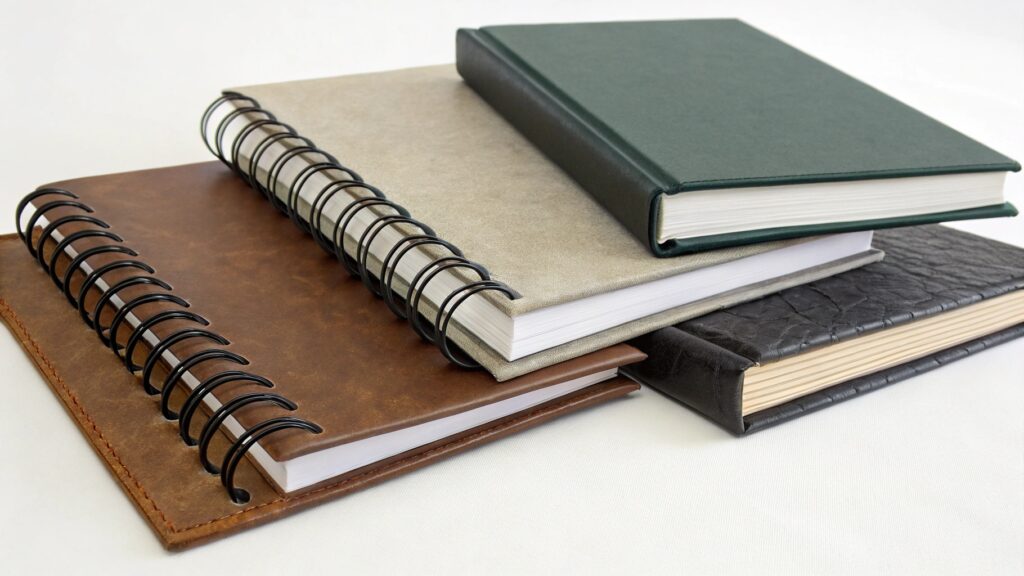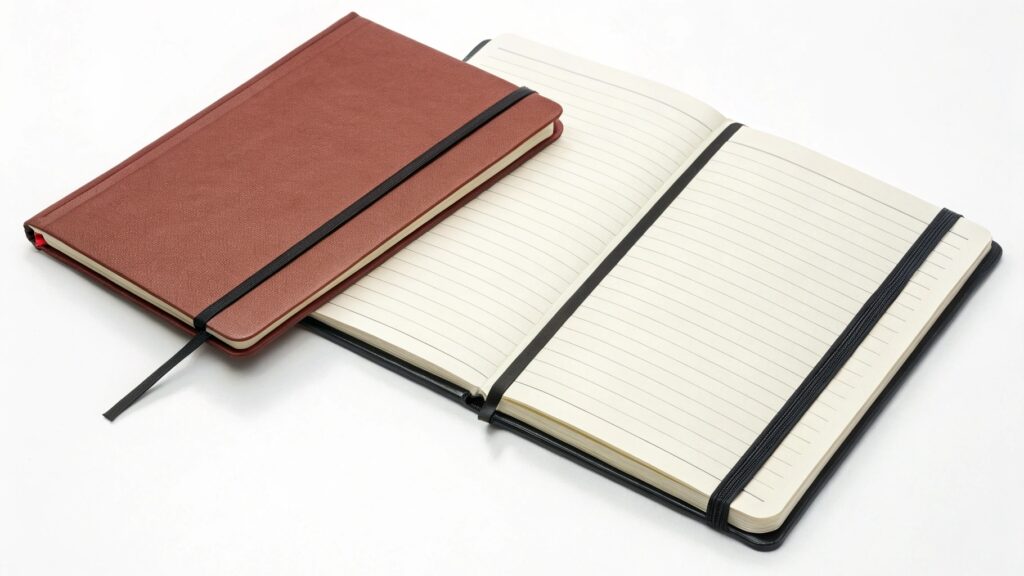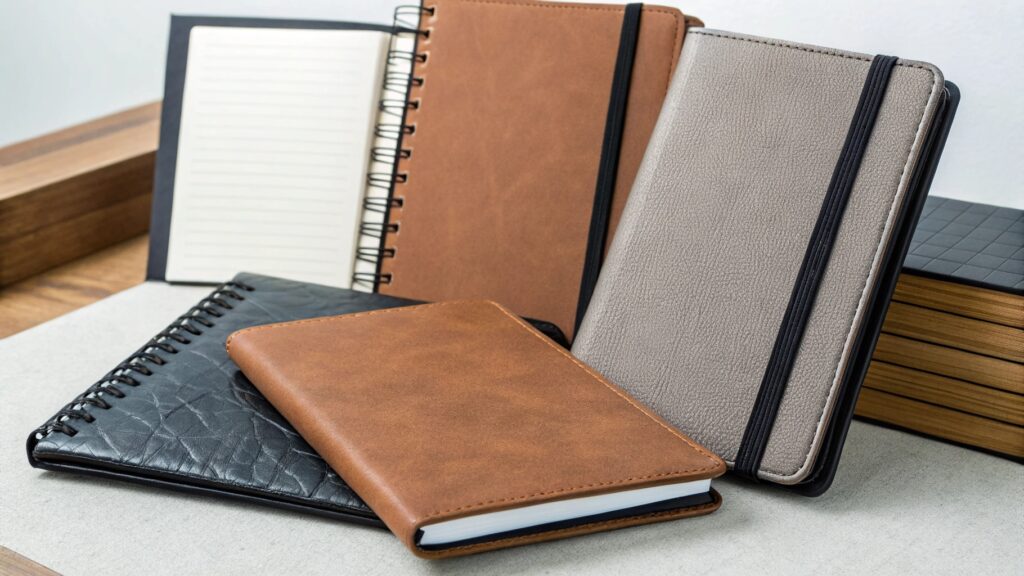What are the Differences Between Notebook Covers: More Than Just Skin Deep
Are you looking for a notebook and wondering about its cover? It's much more than just how it looks. It's about how you use it.
The differences between notebook covers extend beyond aesthetics to material type, flexibility, perceived value, and sustainability, each influencing how you interact with your ideas, the durability of the notebook, and its suitability for various purposes and environments.

From my years of using notebooks, I've learned that the best cover depends on your purpose. It's a functional interface between your ideas and the world.
What are the different types of book covers?
Are you curious about the various types of book covers? Understanding them helps you choose the right one for your needs, whether it's a notebook or a published book.
The different types of book covers1 primarily include hardcover (case-bound), softcover (paperback), spiral/wire-bound, and specialty covers like disc-bound or smart covers, each offering distinct characteristics in terms of durability, flexibility, and aesthetic.

How do hardcover books differ?
Hardcover books, also known as case-bound, have stiff covers made from cardboard or pressboard. This board is covered with paper, cloth, or leather. The pages are usually sewn together and then glued into the cover. This makes them very durable and provides a stable writing surface. They often have a dust jacket. Hardcovers are generally more expensive to produce. They convey a sense of permanence and quality. For notebooks, a hardcover2 means you can write comfortably even without a desk. I prefer hardcover notebooks for journaling or in executive settings because they feel substantial and formal. They are designed to last.
| Cover Type | Material Composition | Flexibility | Durability | Common Uses (Notebooks/Books) |
|---|---|---|---|---|
| Hardcover | Cardboard/Pressboard wrapped in paper, cloth, or leather | Rigid | High | Journals, executive notebooks, textbooks, collector's editions |
| Softcover | Thick paper or cardstock | Flexible | Medium | Everyday notebooks, novels, mass-market paperbacks |
| Spiral/Wire-bound | Cardstock/plastic covers with metal/plastic coil | Flexible | Medium | Student notebooks, sketchbooks, planners |
| Disc-bound | Various, plastic discs | Flexible/Modular | High | Customizable notebooks, planners |
| Smart Cover | Plastic, rubber, often magnetic | Flexible/Rigid | High | Tablets, tech-integrated notebooks |
What are softcover books?
Softcover books, commonly called paperbacks, have covers made from thick paper or cardstock. This material is more flexible than hardcover. The pages are typically glued together (perfect bound) and then directly to the cover. Softcover books are lighter and more portable. They are also less expensive to produce. For notebooks, a softcover3 allows for more flexibility. They are easier to stuff into a bag. However, they may not provide a stable writing surface on the go, and the covers can bend or curl over time. I often use softcover notebooks for daily notes or when I need something light to carry around. They are practical for everyday use.
What are specialty covers?
Specialty covers include options like spiral/wire-bound, disc-bound, and smart covers.
- Spiral/Wire-bound notebooks have covers made of cardstock or plastic, with a metal or plastic coil holding the pages together. This allows the notebook to lay perfectly flat or fold back on itself. Great for students or note-takers.
- Disc-bound notebooks use individual plastic discs instead of a continuous coil. This allows pages to be added, removed, or rearranged easily. They offer high customization.
- Smart Covers are usually seen on tech-integrated notebooks (like Rocketbook). They are often made from hard plastic or polycarbonate. They might have features like erasable surfaces or digital integration. They offer structure and water-resistance, catering to digital-hybrid users.
These specialty covers cater to specific needs, offering unique advantages in terms of functionality and adaptability.
What is the difference between hardcover and softcover notebooks?
Are you trying to decide between a hardcover and a softcover notebook? The key differences impact how you use them.
The main differences between hardcover and softcover notebooks lie in their cover rigidity, durability, portability, and perceived value: hardcovers offer a stable writing surface and greater protection, while softcovers are lighter, more flexible, and often more affordable.

How does cover rigidity impact use?
Cover rigidity is the most obvious difference. A hardcover notebook has a stiff, unyielding cover. This makes it an excellent stable writing surface, even if you are not at a desk. You can write comfortably on your lap, in a park, or while standing. This structure also provides superior protection for the pages inside, guarding against bends and tears. A softcover notebook, with its flexible cover, offers less stability. It will bend with your hand or the surface it's on. This means you generally need a flat, firm surface to write comfortably. I choose a hardcover when I know I'll be writing on the go.
| Feature | Hardcover Notebooks | Softcover Notebooks |
|---|---|---|
| Rigidity | Stiff, rigid | Flexible, pliable |
| Durability | High, pages well protected | Moderate, covers can bend/curl |
| Portability | Heavier, less flexible for tight spaces | Lighter, easier to slip into bags |
| Writing Surface | Stable, good for writing on the go | Needs flat surface for comfortable writing |
| Cost | Generally higher | Generally lower |
| Longevity | Designed for long-term use, archival | More prone to wear and tear over time |
What are the portability differences?
Portability differs significantly between hardcover and softcover notebooks. Hardcovers are heavier and bulkier. While durable, their rigid nature makes them less adaptable to tight spaces in a bag. They maintain their shape, which can sometimes be a disadvantage if you're trying to fit them into an already packed backpack. Softcover notebooks are lighter and more flexible. They can be bent slightly to fit into smaller gaps. They are easier to stuff into a jacket pocket or a small purse. This makes them ideal for travel, daily commutes, or when you want to carry minimal weight. I often opt for softcover if I need extreme portability.
How does perceived value influence choice?
The perceived value of a notebook often influences its choice and how it's used. A hardcover notebook, especially one bound in leather, generally feels more luxurious and substantial. This often leads to more intentional, curated writing. You might feel inclined to use it for important thoughts, journaling, or projects that require permanence. It becomes a personal artifact. A simple softcover notebook, often with a cardboard or flimsy cover, might encourage more free, spontaneous scribbling. It feels less precious. The cover subconsciously creates a contract with how we treat our thoughts inside. This psychological aspect plays a subtle yet powerful role in shaping our interaction with our own ideas.
Which cover is best for a notebook?
Are you trying to find the best cover for a notebook? There isn't a single "best" answer. It depends entirely on your needs and how you plan to use it.
The best cover for a notebook is highly subjective, depending on the user's purpose, environment, and personal preferences regarding durability, portability, writing experience, and aesthetic. Options range from durable hardcovers for stability to flexible softcovers for portability, or specialty covers for specific functionalities.

Why does purpose define the best cover?
The purpose of your notebook defines the best cover.
- If you're using it as a journal or for important long-term notes, a hardcover (especially leather or sturdy fabric) offers durability and a sense of permanence. It protects your thoughts for years.
- For students or daily note-takers, a spiral-bound notebook allows it to lay flat, which is great for taking notes in lectures or labs. Its flexibility is also a plus.
- If you need a sketchbook or a notebook for creative brainstorming where you scribble freely, a simple softcover might be liberating.
- For travelers, a lightweight, flexible softcover or even a water-resistant plastic cover might be ideal for durability and fitting into tight spaces.
The cover needs to align with how you write, where you write, and what you expect your notebook to represent.
| Best Cover Type | Ideal User/Purpose | Key Advantages |
|---|---|---|
| Hardcover | Journals, formal notes, executive use, on-the-go writing | Provides stable surface, high durability, premium feel |
| Softcover | Daily notes, quick thoughts, casual use, budget-conscious | Lightweight, portable, flexible, more affordable |
| Spiral/Wire-bound | Students, note-takers, sketchbooks, recipe books | Lays flat, folds back completely, easy page turning |
| Disc-bound | Highly organized, customizable, mixed media users | Pages can be added/removed/rearranged easily, very flexible |
| Smart Cover (Plastic/Polycarbonate) | Tech-integrated users, outdoor use, reusable | Durable, water-resistant, often compatible with digital apps |
How does environment influence choice?
Your environment heavily influences the best notebook cover choice.
- If you often work outdoors or in rugged conditions, a hard plastic or waxed canvas cover offers better water resistance and protection against wear and tear than a delicate leather or paper cover.
- For office settings, a sleek leather or structured hardcover can project professionalism.
- If you're constantly on the go and stuffing your notebook into various bags, a flexible softcover or a spiral-bound notebook will be more adaptable and less likely to get damaged.
- In humid climates, real leather might not be the best choice as it can be prone to mold or damage.
Considering where and how you'll use the notebook is crucial.
Why is perceived value a factor?
Perceived value is a subtle but important factor. The quality of the cover can subconsciously affect how you treat your notebook and its contents. A luxurious, high-quality leather-bound notebook often encourages more intentional, careful, and curated writing. You might feel that the thoughts within it are more significant. In contrast, a simple, inexpensive cardboard cover might lead to more free-form, less constrained scribbling, as if the content is more temporary. This doesn't mean one is better than the other; it just means the cover sets a tone for your interaction with your ideas. It becomes a psychological choice that shapes your writing habits and respect for your own thoughts.
Conclusion
Choosing a notebook cover is a psychological and functional decision. Align it with how you write, where you write, and what your notebook represents. It's about finding the perfect interface for your ideas.
-
Explore this link to understand the various types of book covers and their unique characteristics, helping you make an informed choice. ↩
-
Discover the advantages of hardcover notebooks, including durability and a stable writing surface, perfect for journaling or professional use. ↩
-
Learn about the benefits of softcover notebooks, including their lightweight and flexible nature, making them ideal for everyday use and portability. ↩





